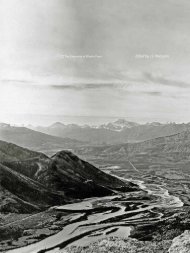C Ihe Ladies c cu. V'VVAN - History and Classics, Department of
C Ihe Ladies c cu. V'VVAN - History and Classics, Department of
C Ihe Ladies c cu. V'VVAN - History and Classics, Department of
- No tags were found...
Create successful ePaper yourself
Turn your PDF publications into a flip-book with our unique Google optimized e-Paper software.
Notes to Page 23 245at the time. The fourth <strong>of</strong> ten children born to Chief Justice <strong>of</strong>Manitoba Sir Joseph <strong>and</strong> Marie-Ann (nee Henault) Dubuc,Lucien studied at theJesuit College <strong>of</strong> St Boniface <strong>and</strong> theUniversity <strong>of</strong> Manitoba, where he received his law degree in1900. Marrying Marguerite Richard, he then moved toEdmonton (Dubuc, "Genealogie"), where he played an activepart in the Francophone community, serving as secretary <strong>of</strong> theSeparate School Board from 1901 to I905 (E.j. Hart 33), as amember <strong>of</strong> the Saint-Jean-Baptiste Association <strong>and</strong> the Societedu parler fran~ais (52), <strong>and</strong> as president <strong>of</strong> the Associationcanadienne-fran~ais de l'Alberta in the late I920s (107).Dubuc ranked among the most prominent French-speakinglawyers in Edmonton. He was called to the Alberta Bench inI920 (III) <strong>and</strong> became the chief justice <strong>of</strong> the Regional Court<strong>of</strong> Northern Alberta in 1944. In May 1924, he became the firstjudge in Alberta's history to hear a case entirely in French(II2). In I937, Dubuc received an honorary Doctor <strong>of</strong> Lawsdegree from Laval University ("News").Dubuc's trip in I926 with the Englishwomen was not thefirst he made to hear a trial in the Arctic. In 1920, FranklinHugo Kitto had reported to the <strong>Department</strong> <strong>of</strong> the Interiorthat "the need for stipendiary magistrates being appointed wasimpressed on [him] at every post. An appeal from a decision <strong>of</strong>a local Justice <strong>of</strong> the Peace is practically an impossibility now"("Report" 29). Likely in response to this situation, in I92IDubuc travelled to Fort Providence <strong>and</strong> Fort McPherson. Heheard many cases, <strong>and</strong>, for the first time, sentenced a man,Albert Lebeau, to death (Philip Godsell, Vanishing I83-90). Thetrial at Fort Providence, held on 29June, was the first trial byjury in the NWT (Fumoleau I72). In I923, Dubuc travelled toHerschel Isl<strong>and</strong>, Yukon to hear the case against two Inuit:Tatamagana (also transcribed as Tatamigina, Tatamageena,<strong>and</strong> Tatamerana) <strong>and</strong> Aligoomiak (also transcribed as AlikOmiak, Alikomaik, <strong>and</strong> Alekamiaq). They were ac<strong>cu</strong>sed <strong>of</strong>killing RCMP Corp W.A. Doak <strong>and</strong> Otto Binder, a whitetrader, in April I922 near Tree River (67"4I'OO" N,Ur"53' 00" W), east <strong>of</strong> Coppermine River in the central Arctic.(A photograph <strong>of</strong> the ac<strong>cu</strong>sed men is reproduced in the papers<strong>of</strong> Knud Rasmussen, the explorer from Greenl<strong>and</strong>/Denmark[Intellectual facing 268].)Extending from 16 to 20 July, the trial ended with the juryfinding the men guilty <strong>of</strong> murder in the first degree <strong>and</strong> Dubucsentencing them to death. This verdict <strong>and</strong> sentence keptDubuc's name in the press for some time. James RichardLucas, the Anglican bishop <strong>of</strong> Mackenzie River 1913-26,attended the trial <strong>and</strong> denounced the verdict, citing suchimproprieties as having the two men testify against oneanother, rendering a verdict on evidence that would not havebeen sufficient to convict white men, bringing the woodneeded to build the gallows with the trial party in advance <strong>of</strong>the proceedings, <strong>and</strong> delaying the sentencing until just beforethe judge's departure from Herschel Isl<strong>and</strong>. Lucas' complaintsstirred a hot debate, especially in eastern Canada, where areprieve was sought on the grounds that the Inuit wereinsufficiently familiar with "the laws <strong>of</strong> civilization." In theend, it was left to the federal cabinet to review the sentence. Itwas confirmed <strong>and</strong> the men were exe<strong>cu</strong>ted at Herschel Isl<strong>and</strong> IFebruary 1924, the first Inuit exe<strong>cu</strong>ted for murder underCanadian law ("Eskimo Murder"; Philip Godsell, Arctic 234-39,255,263,295; Mason 245-49; Morrison I60-6I; FrankPeake, The Bishop I45).However, the trial brought to public awareness both animage <strong>of</strong> Inuit as other than smiling, lovable children <strong>and</strong> thereliance on a policy <strong>of</strong> poliCing them in the absence <strong>of</strong> anypolicy for governing them. So sensational did the English pressfind the story that one newspaper reported the exe<strong>cu</strong>tionsmore than a month before they took place ("EskimosExe<strong>cu</strong>ted"). Rasmussen told the world that he had been"informed that this exe<strong>cu</strong>tion had cost Canada something like$IOO,OOO; among other expensive items being the cost <strong>of</strong> theexe<strong>cu</strong>tioner, who had to be brought up <strong>and</strong> kept there all thewinter, as none <strong>of</strong> the Police themselves would have any h<strong>and</strong>in this part <strong>of</strong> the work" (Across 280).Certainly, the observation made by Vyvyan in her field notefor nJune, but less forcefully in her book, is provocative. Evenmore telling is a remark made in her letter to her mother,dated 3June, when she was still at Waterways, about the trial atAklavik three weeks later: "they only hang Eskimos when theymurder white men, <strong>and</strong> this case was a fellow Eskimo."We reached Waterways in ~4 hoursTwo years later, in 1928, under the impressive name <strong>of</strong> theNorthern Alberta Railway Arctic Express, the train still took23 r/2 hours to complete the trip; the "two passenger cars wereboth so antiquated that by night they were lighted by coal-oillamps that hung precariously from the ceiling" (Fleming 282).Waterways was located three kilometres southeast <strong>of</strong> FortMcMurray, at the mouth <strong>of</strong> Hangingstone River. It, <strong>and</strong> not
















